The Curragh Army Camp
Published in 18th–19th - Century History, Features, Issue 3 (Autumn 1998), Volume 6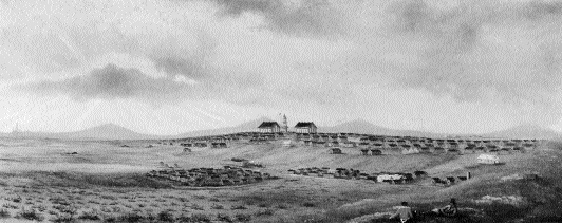
The Curragh Camp in 1861, from a painting by army surgeon Jones Lamprey. (Gorry Gallery, Dublin)
With the outbreak of the Crimean War in 1854 a requirement for additional training areas for the British Army was recognised as an urgent necessity by the government in London. Early in the following year it was announced that camps would be established at Aldershot in Hampshire and on the Curragh of Kildare.
Tradition of encampment
The 5,000 acre plain in County Kildare had, since the earliest times when the legendary men of the Fianna were believed to have trained there, been a welcoming sward to military men. From the end of the sixteenth century onwards there are records of encampment there, and by 1804 the success of the annual summer mustering was confirmed when an extensive panorama by graphic artists of the encampment was put on public display in Dublin ‘bringing to the eye, as a view, a body of 16,000 troops’. The camp was seen as a major military and social occasion, bringing together regular and volunteer soldiers from all parts of the country, and attracting thousands of spectators and camp followers. The influx of such great numbers of men into the area brought advantages and disadvantages to the residents of the Curragh and neighbouring towns, and with the announcement of the making of a temporary encampment for 10,000 infantry there in the spring of 1855 the residents would have been conscious of the implications of the establishment.
The timber hutments were designed as temporary structures which could be dismantled when they were no longer required, but a few permanent buildings—the water works, racquet courts and a clock tower, were also erected. During the construction of the encampment the Irish and English contractors employed hundreds of workmen who were accommodated in huts, or might lodge locally. Two men who choose the latter option were the Denvir brothers from Bushmills. They found lodgings with a widow in her cottage nearby, and she provided the food which they took with them to the site. John Denvir, who was later to join the Fenians in Liverpool, left an account of his time on the plain in which he commented that amongst the military ‘whether regulars or militia, they were driven to wear the uniform by stress of circumstances, as good Irishmen as ever I met’.
The first huts were completed in record time, and by June they were being occupied. The Lord Lieutenant and the commander of the forces in Ireland General Lord Seaton came to inspect the work. Seaton made the sensible suggestion that the ten squares of hutments should be numbered and lettered as ‘such arrangement will be more convenient for the soldiers in the camp, and more easily recollected by them, than any system of names that may be devised’. But in the following month the men were not too happy in their quarters as ‘the rain came in torrents through the roofs which had split and rent in places during the earlier warm spell’.
The building of the encampment was creating wide public interest. Crowds of people came by rail and road to visit, and one journalist described how:
Approaching the Curragh the visitor will perceive in the distance a long line of low habitations, which bear a resemblance to what might be supposed to be the city, or principal abode, of some king or chief of an uncivilised race, such as we have seen described by Mungo Park and other African travellers.
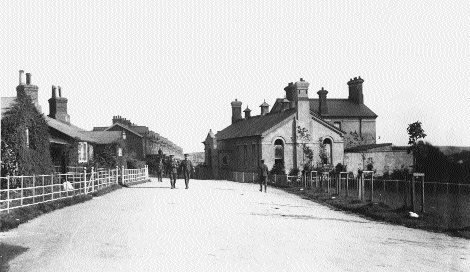
Roman Catholic Institute, Curragh Camp, 1910. (National Library of Ireland)
A soldier’s view from the inside was that the camp was ‘a goodish place, sort of, in dry weather, very healthy, but after twenty-four hours rain, why then, it was ankle deep in mud, like Sebastopol’.
Camp followers
As the troops mustered on the plain, the camp followers likewise congregated there. Sutlers displayed their wares, but sometimes these might cause problems: in 1857 the father of a soldier complained to the commanding general that ‘immoral pictures and jewellery to allure officers into debt’ were being hawked in the camp, but he would have been happy to know that a colporteur was permitted to sell religious tracts there. Denis Barrington O’Sullivan, otherwise known as ‘the wandering star’, also visited the Curragh offering almanacs, song books and holy pictures, and he might entertain the men by composing humorous verse, or giving the solutions to the puzzles in the almanacs which were then popular reading.
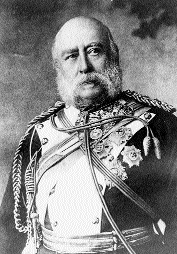
Field Marshall HRH the Duke of Cambridge KG, Colonel-in-Chief 17th Lancers, 1876. In March of that year he ordained that the Curragh should become a camp of instruction.
Smallholders from the neighbourhood brought their vegetables, poultry and dairy produce to sell in the camp market while farmers found good outlets for their hay and oats, horses and cattle through the army contract system. Business in Newbridge, a town which had developed entirely from the building of the barracks there in 1814, prospered even more from the population in the camp, while the car men who ferried their passengers from the Curragh to the railway stations in Kildare and Kilcullen, or to the nearby villages for recreation, developed a constant trade.
Uncertainty as to the future of the encampment arose when the war in the Crimea ended, but from lessons learned on the battlefields it was decided that training camps should be established at which the three arms—infantry, cavalry and artillery—would train together. The Curragh was so designated, and henceforth it was to be the seasonal training ground for the army in Ireland. Each year thousands of men rotated there during the drill period, while the resident population of all ranks, their families and civilian employees numbered about 4,000. Regular and militia regiments met there on the squares and on the sward of the plain, and the major exercises which were held became important events in the social calendar of not alone the county, but of a wide area, including Dublin.
Prince Edward’s time on the short grass
The drill period of 1861 was destined to become the most remembered in the history of the camp: the twenty year old Prince Edward, heir to Queen Victoria, was to spend time on the short grass. Having been greeted on arrival at the camp by a salute from a field battery of the Horse Artillery he settled in to daily routine with the first battalion Grenadier Guards, to which regiment he had been attached. It was also intended that while on the Curragh the prince would be educated on the requirements of his station. It was ordained how he was to occupy each evening of the week: on two evenings he was to entertain senior officers to dinner; he was to dine with the regiments in strict rotation on three days, and on the remaining two evenings he was to dine privately in his quarters, after which he might read or write. He participated in the daily training routines, but his progress was not satisfactory and his superior officer had ‘abandoned all hope that he might be fit to command a battalion by the end of the month’ when his parents were due to arrive on a visit. But his social life prospered, he participated (under the name Captain Melville) in a horse race, he swam under the falls at Poulaphouca, and he climbed the Hill of Allen. As well as dining with his companions in the evenings he joined in their fun, and his dalliance with the actress Nellie Clifden was to cause his mother great distress when she learnt of it. She concluded that the death of Prince Albert later that year was hastened by the prince’s indiscretion as he had worried that Edward’s matrimonial prospects had been damaged by the scandal.
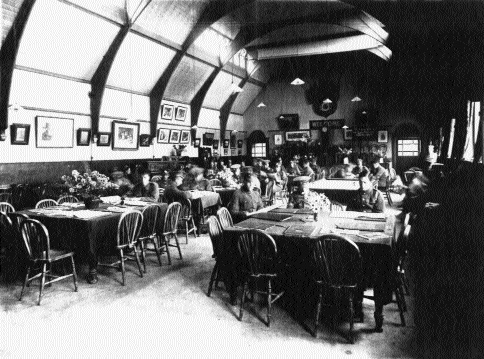
The reading room, Sandes Home, Curragh Camp c. 1900. (National Library of Ireland)
The arrival of Queen Victoria, her consort and other members of the family in the last week of August saw the culmination of weeks of intensive training not alone by the royal heir, but by the 10,000 other soldiers assembled there. Unfortunately the weather was bad, and after a vain effort to shelter under an umbrella the queen was obliged to have her carriage closed. The ‘vast concourse of spectators from Dublin, Kilkenny, Carlow, etc.’ saw the prince lead his company bravely, but the booming of the guns caused them to panic. Then the cavalry charge:
The horses so fast and so high mettled, the men such horsemen and so fearless, the trappings and appointments so first rate, that the eye becomes dazzled as the immense force dashes past in a perfect whirlwind of splendour and the spectators shout with excitement and delight. The charge which was finished without a single accident was a perfect success.
Her Majesty expressed her great satisfaction with the proceedings.
The camp becomes permanent
The reality of the permanence of the encampment on the Curragh was revealed in 1864 when the War Office sought a lease of the sward, a proposal which was rejected by many residents in the county, including Lord Naas whose family seat was near that town. In the House of Commons he said that ‘it was clear that the military occupation of the plain was intended to oust every other interest, and while the advantage of such a large body of consumers would be good, the loss of such a great amount of grazing would be unacceptable’. In May 1866 ‘A Bill to make better provision for the Management and Use of the Curragh of Kildare’ was circulated; it acknowledged that ‘divers persons’ claimed rights there, and the solution to the problem was the establishment of a commission to enquire into and to ascertain rights of common and public rights of way on the plain. The commission of inquiry sat at Newbridge court house for eight days in 1866 and evidence from seventy-one tenants was heard. General Lord Strathnairn led the military witnesses, and gentlemen from the Turf Club, County Grand Jury and the Naas Board of Guardians, as well as land owners, shepherds and local residents all had their say. It was accepted that legislation would be necessary to secure to the crown the power to control certain areas of the plain, and to discharge public and private rights of way there; another commission was to be appointed to ascertain the pasturage and other rights, and what compensation, if any, might be paid. Before that formality was achieved a select committee sat to consider the 1866 bill, and then in July ‘An Act to make better Provision for the management and Use of the Curragh of Kildare’ was passed. It designated the area which would be controlled by the War Department, and authority was given for the making of bye-laws, and which were promulgated in December 1868. The status of the Turf Club was confirmed, and subject to the provisions of the act, all rights of common pasture, rights of way and other rights were to continue as before. In January 1869 three commissioners convened at Newbridge to consider some 400 claims, and in June they published awards to 216 applicants, and the act to confirm the awards was effected in 1870.
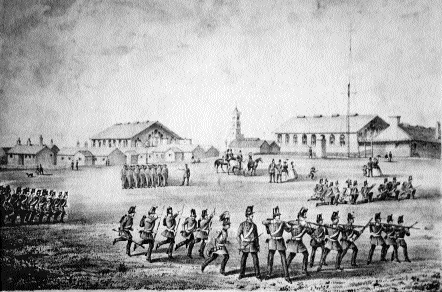
The Curragh Camp headquarters c. 1860-a group of officers and their ladies watch a section of infrantrymen drilling while another practices musketry.
The Curragh Camp was planned as a self-contained unit, a place where the soldier and his family, if he was on the married establishment, would be adequately provided for. There were hospitals, churches and schools, a bakery and an abattoir, canteens, recreation rooms and sports fields. A weekly market and visits from sutlers and travelling salesmen enabled the residents to purchase their necessaries locally, or they might venture into Newbridge for a wider range of goods. However as admission to the married establishment was limited many men elected to wed outside it, with the hope of being admitted in due course. Such brides found no support from the War Office, and the only accommodation they would find was in the cottages on the fringes of the plain, or in the back streets of the nearest towns. In Newbridge the area they occupied was known as the She Barracks. It was not unusual for such women to be left behind by their husbands when a regiment moved to another station, or was despatched overseas. Then the plight of a family could be extreme as the mother sought to support her care, and it was not infrequent that such women fell into prostitution.
Curragh ‘wrens’
The latter profession was to be found in the vicinity of military stations since the earliest times, and from the establishment of barracks in Naas and Newbridge early in the nineteenth century it was prevalent locally. With the development of the camp on the wide open spaces of the Curragh and the seasonal advent of thousands of soldiers the numbers of camp followers of all sorts increased, and the prostitutes soon earned for themselves the sobriquet of wrens. This term was applied to the women as many of them lived all the year round in the furze bushes which are the only ground cover on the plain. There also they might give birth or die, and the health and death of the unfortunates, as they were sometimes termed, was frequently to cause public outrage. While the resulting venereal diseases would make a soldier unfit for duty, and subject to official censure, the condition of the women was their own problem. If they became ill the Relieving Officer was supposed to have them brought by cart to the workhouse at Naas, where, following some years of negotiation, an annual grant from the War Office was paid for their maintenance. When it was proposed that a Lock Hospital for the treatment of the women should be opened in Kildare town it was initially objected to, but when it was realised that it would bring financial gain, work proceeded. It opened in 1869 and subsequent official reports indicate that it was successful in rehabilitating many of the patients, the majority of whom were Irish born and Roman Catholic. The official military view of the problem of prostitution was that it was a necessary evil, especially as it was affecting the health of the troops. If the women, of whom it was estimated in 1865 there were 500 in the locality (figures varied from as low as twenty-six in 1861; 100 was given as a normal number in the drill season), were regarded as a nuisance, especially as they invaded the camp lines at night and displayed themselves openly on the plains, it was accepted that if they lived more discretely and away from the camp, that they could be tolerated. As general Lord Strathnairn had remarked before the Curragh Commission in 1866 ‘of course these women cannot be removed altogether, but they need not be allowed to appear so prominently’. If they were apprehended by the police and lodged in Naas jail the authorities there complained of the additional expense occasioned by their incarceration, while the residents of the Curragh area saw the presence of the women as detrimental, causing scandal to their families and reducing the value of their property. If the enforcement of the Curragh bye-laws and the passing of the Contagious Diseases Act in 1886 (See HI 1.1) greatly reduced the activities of the prostitutes they did not disappear, and when the Irish army moved into the evacuated barracks in 1922 the presence of the women in the district continued to be commented on.
The British army withdraws
The withdrawal of the British Army from stations in the Free State in 1922 was to have serious consequences for the local economy, and this was especially so in County Kildare. Apart from the loss to traders in Newbridge and other towns, the contractors who supplied the barracks with meat, dairy produce, fuel, fodder, and the numerous other requirements of such a substantial and regularly paid number of consumers found themselves without business. Civilian workers, of whom it was estimated there were a thousand during the Great War, and half that number normally, found themselves unemployed. It was estimated that in 1887 the presence of the military in Newbridge and the Curragh was worth £300,000 per annum.
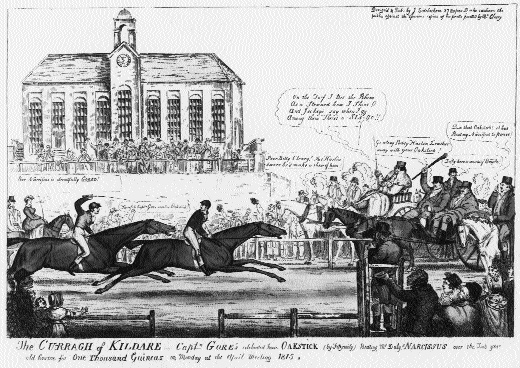
Capt. Robert Gore’s ‘Oakstick’ wins the One Thousand Guineas at the Curragh in 1815. The Standhouse in the background, built before 1777, was to be used as a social centre for the military for many years. (National Library of Ireland)
With the lowering of the Union Jack on the Curragh water tower the ‘smart old days’ were gone. Social life for those who fraternised with the officer class was devastated with the departure of the gentlemen from the racing and hunting fields, the cricket pitch and the polo grounds. For ordinary folk the barrack entertainments were never again to be as lavish, and the soccer games went into decline. As Nora Robertson remarked in later years, ‘the Anglo-Irish vividly remembered the Mecca of the pre-[Great]war Curragh, and the smart old days. Unfair and unkind comparisons would have been made’. Or as an old countryman recalled: ‘many people thought it a sad day they [the British Army] left the Curragh…many people knocked a good do out of them…soldiers were easily codded, not well up. Newbridge missed them very much’.
Con Costello is a retired army officer and President of the County Kildare Archaeological Society.
Further reading:
C. Costello, A Most Delightful Station: the British Army on the Curragh of Kildare, Ireland 1855-1922 (Cork 1996).
C. Costello, Kildare: Saints, Soldiers and Horses (Naas 1991).
F. D’Arcy, Horses, Lords and Racing Men (The Curragh 1991).
















